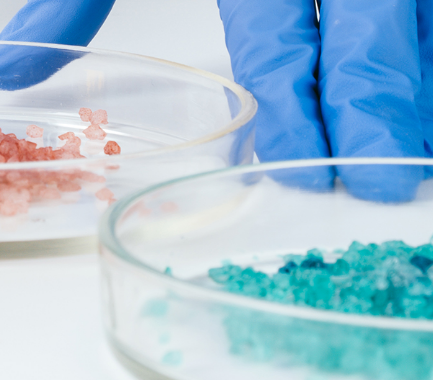Your contact
PENPET-Team - Hamburg

Christoph Meister
Sales
Tel. +49 (0) 40 - 675 7 99 30
sales@penpet.de
Get in touch with us.
Vinyl acetate monomer (VAM)
Vinyl acetate monomer (VAM) is an organic compound that belongs to the carboxylic acid ester family and is of great importance for the chemical industry as a starting material for polymer production. For the large-scale production of the substance in tube bundle reactors, acetic acid is reacted with ethene in a gas-phase oxidation process. There are also production methods based on the hydroesterification of acetic acid and ethyne or on the thermal decomposition of ethylidene diacetate.
The compound is mainly used as a monomer for the production of polyvinyl acetate and as a comonomer for the production of other polymer plastics such as polyvinyl alcohol, ethylene vinyl acetate and ethylene vinyl alcohol products. This makes vinyl acetate monomer an important starting material for the production of paints, varnishes, coatings, adhesives, binders, dispersions, hair gel and solid resins. In addition, it serves as a raw material for many synthetic processes in organic chemistry.
At PENPET, you receive stabilized vinyl acetate monomer (VAM) of the highest quality - from a reliable partner who will also meet your requirements in the long term. We look forward to receiving your inquiry for an individual offer. The liquid compound can be delivered punctually in bulk by tanker or container, as well as in IBC packs and drums of different weights.
CAS no. 108-05-4
EINECS no. 203-545-4
Molecular formula: C4H6O2
Synonyms: VAM, Vinyl Acetate, Ethenyl Acetate, Ethenyl Ethanoate, 1-Acetoxyethylene, Vinyl Acetate
Areas of application: Raw material for the production of polyvinyl acetate, polyvinyl alcohol, ethylene vinyl acetate and other polymeric plastics, intermediate product for the production of resins, paints, varnishes, adhesives, coatings, binders, hair gel and dispersions, raw material for chemical synthesis
More Information
Vinyl acetate monomer (VAM) is a carboxylic acid ester made up of two components that are linked via an ester group. The branched organic compound molecules consist of a vinyl alcohol residue and the residue of acetic acid with the hydroxy and carboxyl functional groups replaced by the linking ester group.
The two carbon atoms of the vinyl alcohol residue have a double bond, which gives vinyl acetate monomer its unsaturated character. The substance therefore has another reactive site and, as an unsaturated ester, can undergo various transesterification and addition reactions. Due to its structure, vinyl acetate monomer is suitable as a starting material for polymerizations.
Under normal storage conditions, vinyl acetate monomer (VAM) is a colorless liquid that gasifies at a temperature of 72°C and reaches its melting point when cooled to -100°C. The highly volatile substance has a fruity, sweet odor that is sometimes described as unpleasant.
Vinyl acetate monomer is only slightly soluble in water and due to its lower density it floats on contact with water. However, the compound is readily soluble in many organic solvents such as ethanol, chloroform, acetone, benzene, diethyl ether, cyclohexane and ethyl acetate.
Vinyl acetate monomer (VAM) is a chemically unstable compound that tends to spontaneously polymerize under the influence of heat, peroxides and light as well as in the presence of acids and bases. In contact with air or moisture, the substance itself can also form explosive peroxides. It should be noted that the added stabilizers become less effective when the connection heats up. Uncontrolled polymerization of vinyl acetate monomer can lead to violent reactions and rupture of containers. The substance enters into further dangerous reactions with considerable generation of heat with ammonia, amines and strong oxidizing agents.
The compound is flammable. The vapors of the highly flammable substance, which can form explosive vapor-air mixtures, pose a particular risk. These mixtures are heavier than the ambient air and can spread unnoticed on the floor of the workroom. To avoid dangerous remote ignition, vinyl acetate monomer must be stored airtight and kept away from possible sources of ignition such as open flames, sparks, electrical discharges and hot surfaces. Combustion of the substance produces carbon dioxide, carbon monoxide, acetaldehyde and other harmful gases.
Vinyl acetate monomer (VAM) poses acute and chronic health hazards. The compound usually only causes slight, temporary irritation and redness on the skin and eyes. However, severe exposure can also cause corneal damage. After contact with the substance, the eyes should be rinsed thoroughly under running water and examined by an ophthalmologist. Soaked parts of the body should also be cleaned immediately with water.
Inhalation of vapors or aerosols of vinyl acetate monomer causes irritation and burning pain in the nose, throat and lower airways. At high concentrations of the compound, pulmonary edema, pneumonia and shortness of breath can also occur. Swallowing the substance can cause irritation of the mucous membranes and gastrointestinal symptoms such as abdominal pain, nausea, vomiting and diarrhea. If large amounts of vinyl acetate monomer are absorbed into the metabolism, disorders of the central nervous system such as drowsiness, dizziness and headaches are possible. In the case of severe poisoning, symptoms similar to those of alcohol intolerance can occur. In addition to rinsing out the mouth and drinking water, immediate medical treatment must be arranged at the scene of the accident. With repeated exposure, vinyl acetate monomer is considered carcinogenic.
The compound is one of the substances that are clearly hazardous to water. A penetration of vinyl acetate monomer into the environment must therefore be avoided. Transportation of the hazardous substance is subject to special regulations.
